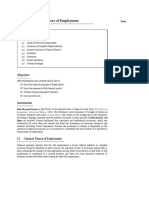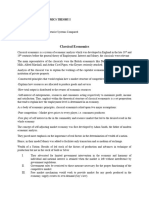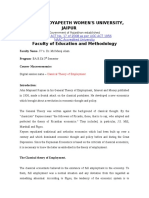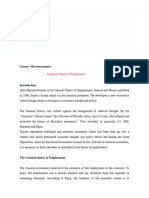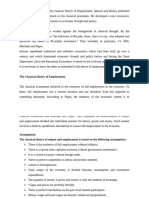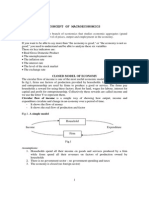0 ratings0% found this document useful (0 votes)
24 viewsUnit 4
Unit 4
Uploaded by
Sandesh KhatiwadaCopyright:
© All Rights Reserved
Available Formats
Download as RTF, PDF, TXT or read online from Scribd
Unit 4
Unit 4
Uploaded by
Sandesh Khatiwada0 ratings0% found this document useful (0 votes)
24 views14 pagesCopyright
© © All Rights Reserved
Available Formats
RTF, PDF, TXT or read online from Scribd
Share this document
Did you find this document useful?
Is this content inappropriate?
Copyright:
© All Rights Reserved
Available Formats
Download as RTF, PDF, TXT or read online from Scribd
Download as rtf, pdf, or txt
0 ratings0% found this document useful (0 votes)
24 views14 pagesUnit 4
Unit 4
Uploaded by
Sandesh KhatiwadaCopyright:
© All Rights Reserved
Available Formats
Download as RTF, PDF, TXT or read online from Scribd
Download as rtf, pdf, or txt
You are on page 1of 14
Unit - 4
Theory of income and employment
Classical Theory of Employment and Output
The classical theory of employment is developed by J.B
say it is also known as "Say's law of Market". The
classical economist like J.S. Mill, Marshall, Pigou, etc.
has supported this law of J.B Say. Classical economists
assumed full employment, free market economy without
government intervention and perfect competition market.
According to them the unemployment is a temporary
phenomenon it will be disappear in long run in perfect
competition market. For the realization of full
employment, there shouldn't be government intervention,
monopoly market and labour unions.
Assumptions
1. Individuals are rational human beings and are
motivated by self interest.
2. There is perfect competition in both product and real
3. People do not have money illusion.
4. Laissez- false condition prevails.
5. There is a closed economy.
6. Technique of production does not change.
7. Money is only medium of exchange.
8. Wages and prices are flexible.
9. The labors are homogenous.
10. There is full employment in the economy.
Components of classical theory of employment and
output
1. Labours Market: According to the classical theory of
employment other things remaining same, wage rate
flexibility assumes that in a competitive market full
employment is provided and full employment output is
produced. Wage rate is determined by the force of
demand and supply of the labour in labour market.
Demand for labour is negative function of real wage
rate and supply of labour is positive function of real
wage rate. The wage rate is determined where the
demand for and supply of labour are equal to each
other. According to the classical theory unemployment
is caused by government interventions, passing
minimum wage legislation. This concept can be
explained with the help of given figure.
In the figure A, X- axis shows the employment Y -axis
shows the real wage rate. DL is the demand curve for
labour and SL is the supply curve of labour. E is the
equilibrium point where DL and SL curve intersect each
other and wage rate and full employment are determined
by (W/P) and ON respectively. If real wage rate is (W/P) 1,
supply of labour is more than its demand so wage rate is
reduced to (W/P) if real wage rate is (W/P) 2 supply of
labour is less that its demand which push the real wage
rate to (W/P). So, the flexibility of wage creates full
employment in the labour market at ON.
In the figure B, X- axis shows the employment and Y-
axis shows the output Y= f (N) and curve represents the
total production function. At full employment level, ON,
the corresponding full employment output is OY.
2. Product market: According to Say's law, full
employment is maintained when whole income is spent
on the purchase of whole output. Total output
comprises of consumer goods (c) and investment goods
(I) and total income is partly spent on consumer
goods(c) and partly saved (S). It can be expressed as :
Total income = Total output
C+S = C+I
S=I
where,
C = consumption
S = saving
I = investment
So, saving investment equality gives the market clearing
situation in the product market. It means saving of
household is scan by business sector in investment.
According to the classical economist interest rate
flexibility makes saving and investment equals. Saving is
the positive function of rate of interest and investment is
the negative function of interest rate. The equilibrium rate
of interest is determined at the level where saving and rate
of interest are equal. It can be explained with the help of
given figure.
In the above figure, x-axis shows the saving and
investment y-axis shows the rate of interest. II represents
investment curve and SS represents the saving curve.
These two curves are intersected at point E. So, rate of
interest is determined by OR and saving investment is
determined by OM. If the rate of interest is OR 1, there is
excess saving and if the rate of interest is OR 2, there is
excess investment. Both the situation is disequilibrium
situation. Hence, rate of interest and saving and
investment are determined OR and OM respectively.
3. Money Market: The classical economists believed in
quantity theory of money. According to this theory the
supply of money determines the price level. Irving
Fisher's equation of exchange status that total
expenditure on final goods and services (MV) is equal
to total value of output (PY).
MV=PY
P= MV/Y.
where ;
P = price level
M = quantity of money
Y = level of aggregate output
V = velocity of circulation of money
According to classical economists, Y and V remain
constant. So, the price level is determined by the quantity
of money (M) and there is positive relationship between
M and P. It can be explained with the help of given figure.
In the figure A, X- axis shows the price level and Y- axis
shows the output. MV is the initial money supply curve.
At full employment level of output OY the price level is
OP. When supply of money increases from MV to M 1V at
constant full employment output OY, the price level
increases to OP1.
In figure B, x-axis shows price level y - axis shows
money wage. (W/P) is the real line. At OP price level, the
money wage is OW when the price level rises to OP 1,
money wage rises to OW1. The price wage combination
OW1 = OP1 is consistent with the full employment real
wage level (W/P) determined in the labour market.
Criticisms of classical theory of employment and
output
The classical theory is criticized by Keynes's criticized
that the classical theory of employment can't solve the
economic problems. The main criticisms are:
1. Under employment equilibrium: According to the
classical economists there is situation of full
employment in free market economy. Flexibility of
wages always tends to full employment equilibrium but
according to Keynes economy is under employment not
full employment.
2. Supply does not create its own demand: According to
J.B say "supply creates its own demand". But Keynes
further told that a part of increased income is spent on
consumer goods and other is saved. There is not any
guarantee that all saved income will be spent on
investment. If investment does not increase in
employment that creates deficiency of demand.
3. No automatic adjustment: Classical economists
believed that economic system is automatic adjusting in
character. But Keynes rejects these automatic adjusting
system due to following preference are;
When liquidity preference is perfectly elastic.
When investment function becomes interest rate
inelastic.
When due to money illusion.
4. Government intervention: Classical economists are
against the government intervention. But Keynes
recommended that government should intervene in
economic activities through economy from
uncertainties.
5. Role of money: According to classical economists
money is only the medium of exchange. Keynes
focused that money has other functions too i.e. star the
value.
6. Saving investment equality: classical economists
emphasized that saving and investment are equal and
this equality is maintained by the rate of interest rate
adjustment mechanism. But investment is determined
by rate of interest and marginal efficiency and capital.
7. Long run analysis: The classical theory of
employment is long run analysis. But Keynes told that
in long run we are dead. Actual problems and they must
be given greater importance.
8. Assumption of perfect competition: The classical
theory's based on the unrealistic assumption of perfect
competition which does not exist in the real world.
9. Not a general theory: The classical theory is not a
general theory it only deals within situation of full
employment but there may be the situation of full
employment, underemployment and employment.
10. Not practical: The classical theory has little practical
significance it does not provide any solution of the
problems of unemployment and trade cycles.
Say's law of Market
Say's law of market is an important law of economics. It
is the foundation of classical economics. The classical
theory of employment and output is based on J.B Say's
law of market. According to Say, "Supply creates its own
demand." This means the production of goods will create
demand for them too because the production not only
supply the goods it also provides the employment to the
people. If employment increases, income and demand for
goods also increases. There is not the possibility of over
production and unemployment in the economy. Say's law
of market applies both in barter and monetary economy.
Assumptions
1. There is existence of free market economy.
2. There is no government intervention and international
trade.
3. Money is only medium of exchange.
4. There is no leakage in the circular flow of income
between different economic units.
5. Wages and prices are flexible.
6. Saving equals to investment.
On the basis of above assumption, we can explain say's
law of market with the help of given figure,
The above figure shows the circular flow of income and
expenditure between business sector and household
sector. It shows that all the resources required by business
sector are provided by the household and all the goods
and services produced by business sectors are purchased
by household sector from the above figure it is clear that
the business sector pay Rs. 4000 to the household sector
for the resources and the household sector also pay Rs.
4000 to the business sector to purchased goods and
services. So, classical economists argued that all the
resources available with household sector are used by
business sector and all the goods and services produced
by business sector are consumed by household sector.
There is not over production and unemployment problems
in the economy.
Implications of Say's law
1. Self- adjusting economy: According to J.B Say's there
is an automatic adjustment in the working of the
economy. If supply increases demand also increases and
adjustment takes place between them.
2. No general over production: There is not the
possibility of over production in the economy .If
production increases, the income of the factor of
production also increases and new demand is created.
3. No general unemployment: There is no general
unemployment and over production. Even if there is
unemployment it is temporary and disappears in the
long run.
4. Flexibility in wages creates full employment:
According to J.B Say if there is unemployment the
wages rate will be decreased and employment is
provided to more workers. For this the government
should not adopt the policy of wages rigidity.
5. Policy implication: The say's law of market is
important for policy implication. According to this law
economy is automatically adjustable; there is no need of
government intervention.
You might also like
- Hasan Zubair - Islamic Banking and Finance-Routledge (2023)Document175 pagesHasan Zubair - Islamic Banking and Finance-Routledge (2023)Muhammad MustaphaNo ratings yet
- Keynesian Theory of Income and EmploymentDocument3 pagesKeynesian Theory of Income and EmploymentDimple Pankaj Desai89% (9)
- Difference Between Classical and Keynesian EconomicsDocument39 pagesDifference Between Classical and Keynesian EconomicsMsKhan007883% (12)
- 3 Mitchell Fixing The EconomyDocument21 pages3 Mitchell Fixing The EconomyJuliethM.LópezArboledaNo ratings yet
- Hyperwage Theory - Street StrategistDocument330 pagesHyperwage Theory - Street StrategistErnesto Lagapa AtupNo ratings yet
- Classical Theory of EmploymentDocument5 pagesClassical Theory of Employmentbhujelaadesh7No ratings yet
- Classical Theory of EmploymentDocument12 pagesClassical Theory of EmploymentRohit Kumar 4170No ratings yet
- Chapter 5 - 23732471 - 2024 - 10 - 18 - 22 - 14Document11 pagesChapter 5 - 23732471 - 2024 - 10 - 18 - 22 - 14mohan2345671100% (1)
- Chapter 3Document8 pagesChapter 3amanjha112113No ratings yet
- UNIT 2-Theories of Output and Employment: - Shilpa Lalwani Assistant Professor Jims, KalkajiDocument21 pagesUNIT 2-Theories of Output and Employment: - Shilpa Lalwani Assistant Professor Jims, KalkajiAlokNo ratings yet
- Module 3 - Classical EconomicsDocument13 pagesModule 3 - Classical EconomicsPrashastiNo ratings yet
- Unit I - Lesson 611Document12 pagesUnit I - Lesson 611adityamehra42297No ratings yet
- Classical Theory of Employment-1Document13 pagesClassical Theory of Employment-1rashpinder singhNo ratings yet
- Eco 303Document8 pagesEco 303agunusmissNo ratings yet
- Module 3Document20 pagesModule 3Pranav AsharNo ratings yet
- Keynesian-Theory-of-EmploymentDocument3 pagesKeynesian-Theory-of-Employmenttmgsuzan000No ratings yet
- S4 - Classical Economics - Part 1Document4 pagesS4 - Classical Economics - Part 1pisiko5060No ratings yet
- Introductory Macroeconomics Semester 2, Economics (Hons.) CBCS Classical Model of Output and Employment Determination Prepared by Abanti GoswamiDocument7 pagesIntroductory Macroeconomics Semester 2, Economics (Hons.) CBCS Classical Model of Output and Employment Determination Prepared by Abanti GoswamiArijit PaulNo ratings yet
- Macro Economics 02 Daily Class Notes Mission JRF June 2024 - Economics PDFDocument26 pagesMacro Economics 02 Daily Class Notes Mission JRF June 2024 - Economics PDFkg704939No ratings yet
- Chapter 4 1Document49 pagesChapter 4 1ashishthapad1No ratings yet
- Economics Classical TheoryDocument7 pagesEconomics Classical Theorysimz007No ratings yet
- Keynesiantheoryofincomedetermination 140303110359 Phpapp02Document26 pagesKeynesiantheoryofincomedetermination 140303110359 Phpapp02ArshaanNo ratings yet
- Theory of Income and EmploymentDocument9 pagesTheory of Income and EmploymentsureshNo ratings yet
- Unit 4 - Class 3 PPT - Classical & Keynesian ApproachDocument24 pagesUnit 4 - Class 3 PPT - Classical & Keynesian Approachshivam kumarNo ratings yet
- Jayoti Vidyapeeth Women'S University, Jaipur: Through ACT No. 17 of 2008 As Per UGC ACT 1956 NAAC Accredited UniversityDocument9 pagesJayoti Vidyapeeth Women'S University, Jaipur: Through ACT No. 17 of 2008 As Per UGC ACT 1956 NAAC Accredited UniversityDunichand chorenNo ratings yet
- Department of Finance: 12 Batch, 2 Year 2 SemesterDocument7 pagesDepartment of Finance: 12 Batch, 2 Year 2 SemesterYasir ArafatNo ratings yet
- EconomicsDocument14 pagesEconomicssantumahapatra4No ratings yet
- Theory of EmploymentDocument7 pagesTheory of EmploymentRotaba MahikNo ratings yet
- Classical Economy, Says Law, Quantity Theory of MoneyDocument14 pagesClassical Economy, Says Law, Quantity Theory of MoneyNithin KrishnaNo ratings yet
- Classical theory of employment LECTURE NOTESDocument9 pagesClassical theory of employment LECTURE NOTESHabiba KausarNo ratings yet
- Keynestheory 1Document6 pagesKeynestheory 1Tez StatusNo ratings yet
- Classical theory of employment II-outputDocument9 pagesClassical theory of employment II-outputHabiba KausarNo ratings yet
- Schools of Economic ThoughtDocument10 pagesSchools of Economic ThoughtSOURAV MONDALNo ratings yet
- PPT Classical & Keynes Theory of Income & EmploymentDocument48 pagesPPT Classical & Keynes Theory of Income & Employmentkamakshi.aggarwal.ug22No ratings yet
- Q. What Do You Understands by Effective Demand? Will The Level of Effective Demand Be Always Associated With Full Employment?Document7 pagesQ. What Do You Understands by Effective Demand? Will The Level of Effective Demand Be Always Associated With Full Employment?Rachit GuptaNo ratings yet
- Classical Theory of Ecomomics 1Document46 pagesClassical Theory of Ecomomics 1Shireen YakubNo ratings yet
- Classical Theory of Employment & Income: "Say's Law of Market"Document43 pagesClassical Theory of Employment & Income: "Say's Law of Market"Souvik DeNo ratings yet
- Classical Model 1Document6 pagesClassical Model 1blipbruceNo ratings yet
- Classical Theory of Macro EconomicsDocument9 pagesClassical Theory of Macro EconomicsSantosh Chhetri100% (2)
- Sitedata Temp Turnitintool 592372239. 6458 1417615254 3051Document8 pagesSitedata Temp Turnitintool 592372239. 6458 1417615254 3051Tayyeba ShoaibNo ratings yet
- Classical Theory of Employment and OutputDocument5 pagesClassical Theory of Employment and OutputKINGS GroupNo ratings yet
- UNIT-II Macroeconomic School of ThoughtDocument28 pagesUNIT-II Macroeconomic School of Thoughtsheetal rajputNo ratings yet
- Contrast Between Classical and Keynesian EconomicsDocument3 pagesContrast Between Classical and Keynesian EconomicsVishwak Sena ReddyNo ratings yet
- 0000001635-Macroeconomics For ManagersDocument19 pages0000001635-Macroeconomics For ManagersVigneshVardharajanNo ratings yet
- Classical Theory of Income & Employment (Lecture - 6)Document18 pagesClassical Theory of Income & Employment (Lecture - 6)Salman HaiderNo ratings yet
- Theory of Employment and OutputDocument20 pagesTheory of Employment and Outputkarthikraj9400No ratings yet
- The Classical Theory of EmploymentDocument9 pagesThe Classical Theory of EmploymentArsh DeepNo ratings yet
- Theory of Income and EmploymentDocument12 pagesTheory of Income and EmploymentShreyash HemromNo ratings yet
- Notes Classical vs. Keynesian ModelDocument34 pagesNotes Classical vs. Keynesian ModelNitish KhatanaNo ratings yet
- ME - Unit 3 IDocument8 pagesME - Unit 3 IVipul DhasmanaNo ratings yet
- Classical Theory of Employment 1Document4 pagesClassical Theory of Employment 1Dar SartajNo ratings yet
- Assignment On Intermediate Macro Economic (ECN 303) - USEDDocument6 pagesAssignment On Intermediate Macro Economic (ECN 303) - USEDBernardokpeNo ratings yet
- Economics MacroDocument131 pagesEconomics MacrosejaldataNo ratings yet
- Theories of Employment: Concept & MeaningDocument30 pagesTheories of Employment: Concept & MeaningYograj PandeyaNo ratings yet
- Concept of MacroeconomyDocument7 pagesConcept of MacroeconomyTathagata ChakrabortiNo ratings yet
- Wa0002.Document10 pagesWa0002.LAKSHYA SHARMANo ratings yet
- Classicals Vs Keynes PDFDocument3 pagesClassicals Vs Keynes PDFQarsam IlyasNo ratings yet
- Keynes' Theory of Income and UnemploymentDocument7 pagesKeynes' Theory of Income and UnemploymentPRIYANSHI AGRAWAL 1933360No ratings yet
- Module C: Simple Theory of Income DeterminationDocument11 pagesModule C: Simple Theory of Income DeterminationGolamSarwarNo ratings yet
- Classical Theory of EmploymentDocument9 pagesClassical Theory of EmploymentProf. (Dr.) M. K. GhadoliyaNo ratings yet
- The Keynesian Model: Intermediate MacroeconomicsDocument14 pagesThe Keynesian Model: Intermediate MacroeconomicshongphakdeyNo ratings yet
- Basic Macroeconomics Module Part 1Document132 pagesBasic Macroeconomics Module Part 1Teddy DerNo ratings yet
- Samara University: College of Business and EconomicsDocument7 pagesSamara University: College of Business and EconomicsGebremeden AnduamlakNo ratings yet
- Macro Economics NotesDocument18 pagesMacro Economics NotesKhalid Aziz100% (1)
- Robert Lekachman Eds. Keynes' General Theory Reports of Three DecadesDocument355 pagesRobert Lekachman Eds. Keynes' General Theory Reports of Three DecadesFatima Romina ArroyoNo ratings yet
- International Business AU PDFDocument264 pagesInternational Business AU PDFNiranjan Kumar100% (1)
- (FREE PDF Sample) The General Theory and After Part 1 Preparation 2nd Ed. Edition Keynes EbooksDocument84 pages(FREE PDF Sample) The General Theory and After Part 1 Preparation 2nd Ed. Edition Keynes EbooksvenarceesarNo ratings yet
- MhizhaDocument84 pagesMhizhaInnocent MakayaNo ratings yet
- The Heterodox ApproachDocument13 pagesThe Heterodox ApproachCeline YapNo ratings yet
- Review of Literature: Section 1Document40 pagesReview of Literature: Section 1777priyankaNo ratings yet
- Towards Theory of SecondhandDocument20 pagesTowards Theory of SecondhandSita W. SuparyonoNo ratings yet
- Comparision Between The Classical Theory of Development and Keynesian'S View On Development Economics-IiDocument27 pagesComparision Between The Classical Theory of Development and Keynesian'S View On Development Economics-IiMoon MishraNo ratings yet
- The Keynesian Revolution and Its CriticsDocument21 pagesThe Keynesian Revolution and Its CriticsGlenn Sabanal GarciaNo ratings yet
- 1958 - Tobin - Liquidity Preferencesas Behaviour Towards Risk PDFDocument23 pages1958 - Tobin - Liquidity Preferencesas Behaviour Towards Risk PDFDiego ManzurNo ratings yet
- Buffett Book RecDocument3 pagesBuffett Book Reclintien6608No ratings yet
- Mock Cat 2Document88 pagesMock Cat 2Arshdeep SinghNo ratings yet
- Klein - The Life of John Maynard KeynesDocument10 pagesKlein - The Life of John Maynard KeyneseddieNo ratings yet
- Schumpeter S Theory of Economic DevelopmDocument17 pagesSchumpeter S Theory of Economic Developmaswathy dasNo ratings yet
- Paul Mattick 1969 Marx Keynes Limits of The Mixed EconDocument392 pagesPaul Mattick 1969 Marx Keynes Limits of The Mixed EconJohn Doubleplus GoodmanNo ratings yet
- The General Theory (Keynes)Document321 pagesThe General Theory (Keynes)Thewins KunyukNo ratings yet
- Theory of Consumption Function 11Document6 pagesTheory of Consumption Function 11Rohit Kumar 4170No ratings yet
- KeynesDocument13 pagesKeynessara.sjohnson0809No ratings yet
- V Jothi Prakas-116 PDFDocument13 pagesV Jothi Prakas-116 PDFUmesh NaikNo ratings yet
- GPE 7.11 Keynes Capital Mobility and The Crisis of Embedded LiberalismDocument26 pagesGPE 7.11 Keynes Capital Mobility and The Crisis of Embedded LiberalismMandy SeitanidouNo ratings yet
- Keynes and National Income MultiplierDocument30 pagesKeynes and National Income MultiplierfarahNo ratings yet
- Chapter 6 Unit 2 - UnlockedDocument41 pagesChapter 6 Unit 2 - UnlockedSanay ShahNo ratings yet
- Champernowne IS-LMDocument17 pagesChampernowne IS-LMeddieNo ratings yet
- ME - Unit 3 IDocument8 pagesME - Unit 3 IVipul DhasmanaNo ratings yet






